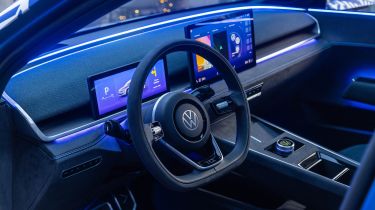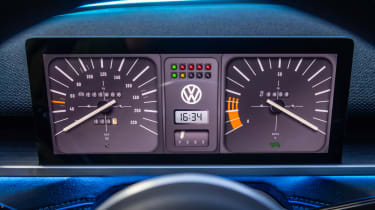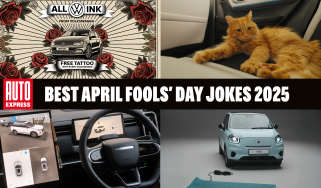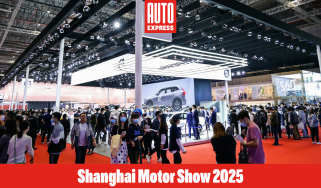A look inside the Volkswagen ID.2all concept: the future of VW interiors
Volkswagen's forthcoming small EV will feature the brand's all-new interior design
Volkswagen has revealed a working interior of its ID. 2all concept car that’s set to influence future Volkswagen cabins, and Auto Express was invited along to try it out for the first time.
The concept car was revealed last March as a thinly-disguised preview of a new, small all-electric model to sit below the ID.3 – although insiders have revealed that it’s not a given that it will be called ID. 2. However, back then, other than a few design sketches, the concept had no real interior – until now.
“We really wanted to dial up the value,” Volkswagen’s head of design Andreas Mindt told us. “We’re getting rid of any hard plastics and upping the quality, while getting the price down. We’re doing that with new thinking and reducing complexity – for example, on the door we’re combining the arm rest with the grab handle and door opener.”
Mindt reiterated that Volkswagen wants to be seen as a “love brand” with “the most intense of all bonds between brand and consumer”. And as Volkswagen brand CEO Thomas Schafer had previously told us, that starts with listening to customers – and acting on what they hear.
“You’ll see some physical switches and dials in addition to a touchscreen – that’s directly responding to feedback,” said Mindt.
The ID. 2all’s dashboard follows a minimalist trend, with a cloth-covered dash top covering hidden air vents underlined by a full-width metallic strip below. Under that sits a wooden section with cloth again covering the lower part, intersected by a thin strip of LED lighting. Another LED strip sits at the base of the windscreen where it meets the dash and there’s a further light strip on the doors, which are also cloth covered.
VW’s interior designer, Darius Watola, sat with us and talked us through the design, starting with the decision to retain a screen in front of the driver where other brands stick with a single central display.
“We think a proper driving screen is important,” said Watola. “You need the important driving information in front of you, that’s why we kept it – it’s safer. And in this case it’s bigger than the other cars – in the ID. 3 it’s five inches and in this car we’re running with an 11-inch screen for the driver and a 13-inch centre screen.”
Below the centre screen sits a slim row of nine buttons controlling the climate control and hazard lights. On top of the double-height centre console, behind a pair of wireless charging pads, is a rotary controller which, in the case of the concept, is used to cycle through three different screen modes.
These are part of what Mindt describes as Volkswagen’s Secret Sauce, one of three design attributes being used across the brand alongside Stable and Likeable. The Secret Sauce adds a sense of humour and surprise to the cars; in this instance giving the two screens either retro graphics inspired by the original Beetle or 70s Golf, or a modern look. And when the middle screen sleeps there’s a graphic of a sleeping wolf – a reference to VW’s HQ in Wolfsburg – which wakes up and stretches as the screen comes back to life.
The wipers and indicators are both controlled on the left stalk, with a drive selector behind the single spoke steering wheel on the right. And that wheel features beautifully milled scrolling dials rather than the touch sensitive buttons on some current models – again a result of customer feedback.
Even the front seats have surprise-and-delight features, as Watola explains. “There are speakers in the head restraints and magnets for rear passengers to put their mobile phone on the back of the seats. And you are sitting on the cinema bench that folds upwards for extra storage.”
Sure enough, as we move into the back of the car, the rear bench lifts upwards freeing up space underneath with charging facilities, or you can even store a bike – with the front wheel removed – where the rear seats usually sit, a feature pioneered by the Honda Jazz.
There’s another neat feature in the boot where the false floor lifts to reveal another hidden storage area, in this case deep enough for two large crates of drinks.
Although some of the more luxurious fixtures and fittings will probably only find their way onto the more expensive models, Watola confirmed that the aim was still to get the car to market at a price close to 25,000 Euros – £21,500 at current exchange rates. The production version will be seen some time next year, with first cars being delivered in 2026.
Now read more about the best small electric cars on sale...
Find a car with the experts










